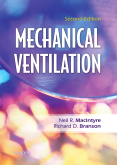|
|
|
| |
 |
|
|

|
 推薦指數:
推薦指數:





|
|
- 內容介紹
|
Mechanical Ventilation, 2nd Edition
By Neil R. MacIntyre, MD, FAARC and Richard D. Branson, BA, MSc, RRT
528 pages 243 ills
Trim size 7 1/4 X 10 1/4 in
Copyright 2008
Description
With cutting-edge and clinically relevant information, MECHANICAL VENTILATION, 2nd Edition takes a practical, clinical approach to the principles and practice of mechanical ventilation. This informative resource explains mechanical ventilation decisions and procedures in real-world terms so information is easy to understand and apply. This thoroughly updated edition includes one new chapter, four completely updated chapters, and a wealth of new user-friendly features.
Key Features
Detailed, clinically focused coverage of the application of mechanical ventilation to the most common respiratory diseases, provides practical answers to real life problems.
UNIQUE! Sections of chapters on Special Techniques and Future Therapies include information on the newest techniques for treating patients in respiratory distress.
A separate appendix of case studies helps you apply what you’ve learned to realistic situations.
Well-known and respected authors, Neil MacIntyre and Rich Branson, share their vast expertise and accurate, cutting-edge information.
New to this Edition
Chapter Objectives, Key Point Summaries, and Assessment Questions reinforce basic concepts from each chapter.
New chapter on Unique Patient Populations highlights the mechanical ventilation issues of traumatic brain injury, neuromuscular disease, lung transplantation, burn injury, and perioperative patient populations.
Expanded glossary includes relevant terminology and key terms to help you easily find unfamiliar terminology.
Table of Contents
Section I: Technical Aspects
1. Classification of Mechanical Ventilators
2. Modes of Ventilator Operation
3. The Patient-Ventilator Interface: Ventilator Circuit, Airway Care, and Suctioning
4. Humidification and Aerosol Therapy
5. Ventilator Monitors and Displays
Section II: Physiology
6. Respiratory System Mechanics
7. Alveolar-Capillary Gas Transport
8. Patient-Ventilator Interactions
9. Cardiopulmonary Interactions
10. Ventilator Induced Lung Injury
Section III: Adjunctive Therapy
11. Nutrition
12. Sedation, Analgesia, and Neuromuscular Blockade
13. Patient Positioning
14. Ventilator Associated Pneumonia
Section IV: Clinical Applications
15. Management of Parenchymal Lung Injury
16. Management of Obstructive Airway Disease
17. Unique Patient Populations NEW!
18. Discontinuing Mechanical Support
19. Prolonged Mechanical Ventilation
20. Transport and Resuscitation
21. Non-invasive Ventilation
Section V: Special Techniques and Future Therapies
22. Modifications on Conventional Ventilation Techniques
23. High-Frequency Ventilation
24. Extracorporeal Techniques for Cardiopulmonary Support
25. Heliox and Inhaled Nitric Oxide
Appendices
Case Studies
Assessment Question Answers
Glossary
|
|
|

